Think a closed door is enough to stop interruptions? Think again. Learn why visual signals like BusyBox outperform closed doors when it comes to clarity, boundaries, and workplace culture.
“I Just Close My Door” … The Most Common Misunderstanding
It’s a comment we hear often: “I don’t need a BusyBox. I just close (lock) my office door.” Here’s the problem.
A closed door doesn’t actually say anything. It leaves people guessing.
- Are you in a meeting?
- Are you on a call?
- Are you just trying to focus?
- Can I knock?
- Will I offend you if I interrupt?
- Are you even in the room right now? 🤷♂️
This ambiguity causes hesitation, confusion, and, ironically, more interruptions, not fewer.
Doors Say “Closed.” BusyBox Says Why.
The door may be shut, but your intent is invisible. BusyBox adds meaning to that moment. It makes your state explicit, not implied. Compare these two experiences:
🔒 Closed Door Only
- Leaves coworkers unsure
- Encourages people to knock “just in case”
- Feels unwelcoming, even when it’s not
- Doesn’t signal when you’re free again
💡 BusyBox Smart Sign
- Shows your exact status (e.g. “Super Busy,” “On a Call,” “Busy but okay to interrupt if needed for something important to deal with right now”)
- Prevents awkward interruptions …
- “Can I interrupt?” …
- “Please no. Well, since you interrupted, what do you need?” + Ugh.
- Awwwwwwkward for everyone
- Can flip status to “Available” the moment you finish
- Builds shared norms around respectful time blocking
“I used to get interrupted constantly, even with my door closed. Since adding BusyBox, those moments have basically disappeared.” — BusyBox user, partner at a law firm
What a Door Can’t Do (That BusyBox Can)
🚫 A door can’t change colors
🚫 A door can’t sync with your calendar
🚫 A door can’t display a “level of interruptability” message
🚫 A door can’t say “Focus Mode now, I’ll signal when I’m done.”
BusyBox can do all of that … and more … in seconds.
Whether you control it with your phone, a remote, your Stream Deck, or Microsoft Teams slash commands, IFTTT, Slack or Zoom, BusyBox puts the signal in your hands.
Behavioral Science Backing: Visibility = Better Decisions
The human brain responds more effectively to explicit, visual signals than subtle ones.
That’s why:
- Traffic lights beat yield signs 🚦
- “Recording” lights work in studios 🎙️
- Open/Closed signs matter in stores 🚪
- Airplane signs tell you when to buckle up or stay seated
BusyBox works the same way. It creates instant clarity for your coworkers, team, or family. Clarity reduces interruptions. Fewer interruptions = better output, fewer mistakes, and less stress.
Real-World Example: Office Culture Shift with BusyBox
A legal firm introduced BusyBox signs across all their private offices.
Before BusyBox, staff knocked even when doors were shut, just to “check in” and to be social. “Did you catch the game last night?” We know and understand the social pressures of an office environment.
After one week of using BusyBox:
✅ Interruptions dropped significantly
✅ Staff reported less stress and better flow
✅ Office-wide norms began to shift: when the light was on, people respected it
✅ People became more intentional about when to reach out
A closed door says “you’re not visible.”
BusyBox says “I’m working, and I’ll be ready soon.”
Signaling availability means “Checking in without hesitation or worries.”
Why Visual Signals Work in Hybrid Offices Too
Even if you’re in a hybrid setup using “hotelling” or rotating office space, BusyBox adds a layer of consistency.
🧠 Your coworkers don’t need to remember where you’re sitting or if that door being shut means “go away” or “try again in 5, or 15, or 30 minutes."
They just look at the light.
From home, BusyBox signals to your family or roommates that you’re actively focused or in a virtual meeting. No guesswork.
It becomes your “focus perimeter,” no matter where you work.
BusyBox and Doors: Better Together
This isn’t about replacing the door. It’s about enhancing what the door communicates. Keep the door. But make it smarter.
Use BusyBox to:
- Show when a quiet room is in use
- Communicate specific messages
- Create a cultural shift where people check the light before interrupting
- Signal when you’re available again
Final Thought: Which Message Are You Sending?
A closed door may say “not right now” but only if you’re consistent with it and people understand that they are to interpret it that way. BusyBox says “here’s what I’m doing and when I’ll be available. That difference matters. Especially when the work you’re doing is deep, valuable, and easily derailed.
FAQ: BusyBox vs. Traditional Do-Not-Disturb Methods
Q: Isn’t a closed door enough? Not usually. It leaves people unsure. BusyBox shows your intent clearly, reducing hesitation and interruptions.
Q: Can I use both? Absolutely. In fact, pairing BusyBox with a door gives you the best of both worlds, privacy and clarity.
Q: Will people actually respect the sign? Yes. When it’s visual, consistent, and part of the culture, people respect it. Just like a “Recording” light or a red traffic light.





















